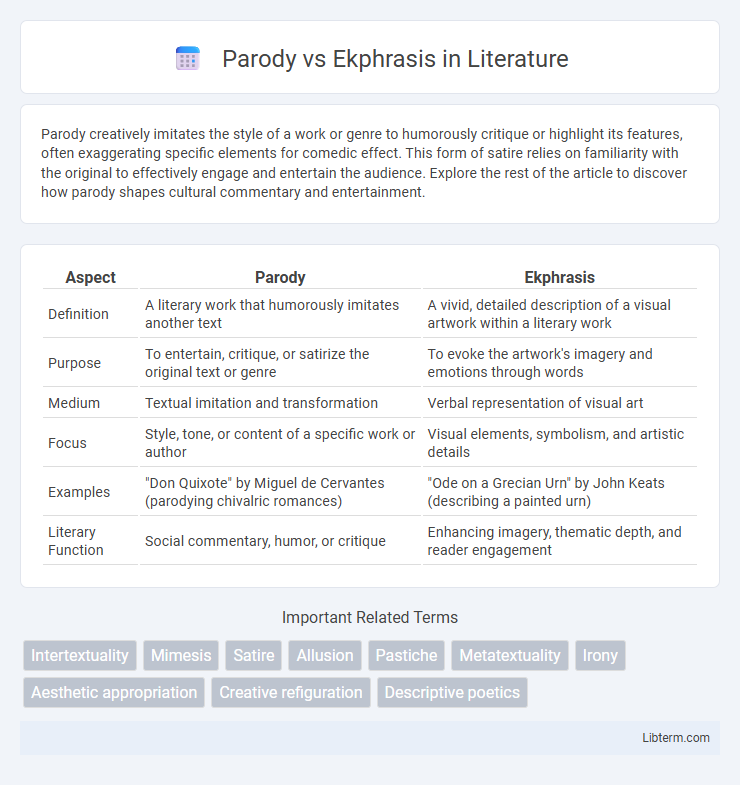Parody creatively imitates the style of a work or genre to humorously critique or highlight its features, often exaggerating specific elements for comedic effect. This form of satire relies on familiarity with the original to effectively engage and entertain the audience. Explore the rest of the article to discover how parody shapes cultural commentary and entertainment.
Table of Comparison
| Aspect | Parody | Ekphrasis |
|---|---|---|
| Definition | A literary work that humorously imitates another text | A vivid, detailed description of a visual artwork within a literary work |
| Purpose | To entertain, critique, or satirize the original text or genre | To evoke the artwork's imagery and emotions through words |
| Medium | Textual imitation and transformation | Verbal representation of visual art |
| Focus | Style, tone, or content of a specific work or author | Visual elements, symbolism, and artistic details |
| Examples | "Don Quixote" by Miguel de Cervantes (parodying chivalric romances) | "Ode on a Grecian Urn" by John Keats (describing a painted urn) |
| Literary Function | Social commentary, humor, or critique | Enhancing imagery, thematic depth, and reader engagement |
Defining Parody and Ekphrasis
Parody is a creative work that humorously imitates another work, artist, or genre to critique or entertain by exaggerating distinctive features. Ekphrasis is a vivid, often dramatic, literary description of a visual artwork, designed to bring the image to life through words. Both forms engage intertextually, but parody transforms the source's meaning, while ekphrasis interprets and amplifies a visual piece.
Historical Origins and Evolution
Parody originated in ancient Greece as a form of literary and dramatic imitation used to critique or mock original works, evolving through Roman times and flourishing in Renaissance literature as a tool for satire and social commentary. Ekphrasis began in classical antiquity as a vivid, often poetic description of visual art to evoke sensory experience, with roots in Homeric epics and later developments in Hellenistic and Roman literary traditions. Both genres have evolved to adapt to contemporary media, with parody expanding into film and digital formats while ekphrasis continues to inspire cross-disciplinary artistic expressions.
Key Features of Parody
Parody imitates the style, tone, or content of an original work with exaggeration and humor to critique or entertain, often relying on recognizable elements for its impact. It uses satire, irony, and exaggeration to highlight flaws or absurdities, creating a transformative reinterpretation that retains clear ties to the source. Parody's key features include mimicry, comedic intent, and intertextuality, distinguishing it from ekphrasis, which primarily focuses on vivid verbal descriptions of visual art.
Core Elements of Ekphrasis
Ekphrasis centers on vivid, detailed descriptions of visual art, aiming to evoke the artwork's emotional and sensory experience through language. Core elements include a strong narrative voice, rich imagery, and an intimate engagement with the artwork's form, content, and historical context. Unlike parody, which humorously imitates or critiques, ekphrasis seeks to translate visual stimuli into poetic or literary expression, deepening the audience's connection to the original piece.
Purpose and Intent in Parody
Parody primarily serves the purpose of humor, criticism, or social commentary by imitating and exaggerating the style or content of an original work to highlight its flaws or absurdities. Its intent is often to entertain while provoking thought or challenging the original's themes and conventions. Unlike ekphrasis, which aims to vividly describe and evoke the essence of visual art through language, parody engages with the source material through mimicry and satire to generate a critical dialogue.
Interpretive Functions of Ekphrasis
Ekphrasis serves as a dynamic interpretive function by transforming visual art into vivid, descriptive literary expressions that invite readers to engage imaginatively with the original artwork. Unlike parody, which critiques or mocks through imitation, ekphrasis deepens understanding by revealing new perspectives and emotional nuances embedded within the visual piece. This interpretive act bridges sensory experiences, allowing readers to explore underlying themes, symbolism, and cultural contexts beyond the artwork's immediate visual impact.
Parody vs Ekphrasis in Literature
Parody in literature involves the humorous or satirical imitation of a particular work, style, or author to critique or entertain, often using exaggeration and irony. Ekphrasis, by contrast, is the vivid, detailed description of a work of art within a literary text, aiming to evoke the visual experience and deepen thematic resonance. Both techniques engage intertextuality, but parody transforms content for comedic or critical effect, while ekphrasis enriches narrative through evocative imagery.
Visual Arts: Mimicry and Description
Parody in visual arts emphasizes mimicry through humorous or satirical imitation, often exaggerating stylistic features to critique or celebrate the original work. Ekphrasis involves detailed, vivid description of visual art within a text, aiming to evoke the artwork's essence and provoke a sensory or emotional response. Both techniques engage with visual culture, but parody relies on reinterpretation while ekphrasis focuses on verbal representation.
Contemporary Examples and Applications
Parody reinterprets existing works by imitating style and content to create humor or critique, often seen in contemporary digital media such as YouTube videos and satirical articles. Ekphrasis involves vivid, detailed descriptions of visual art in literature, exemplified today by poets like Terrance Hayes who transform paintings into lyrical narratives. Both approaches engage intertextually, with parody emphasizing cultural commentary and ekphrasis fostering visual-literary dialogue in modern creative expressions.
The Interplay Between Parody and Ekphrasis
Parody and ekphrasis intersect through their creative reimaginings of original works, where parody humorously transforms or critiques a source, and ekphrasis vividly describes or interprets visual art in textual form. The interplay between parody and ekphrasis enriches literary and artistic expression by blending evocative description with satirical commentary. This synergy intensifies audience engagement, inviting deeper reflection on the original artwork's meaning and cultural significance.
Parody Infographic

 libterm.com
libterm.com